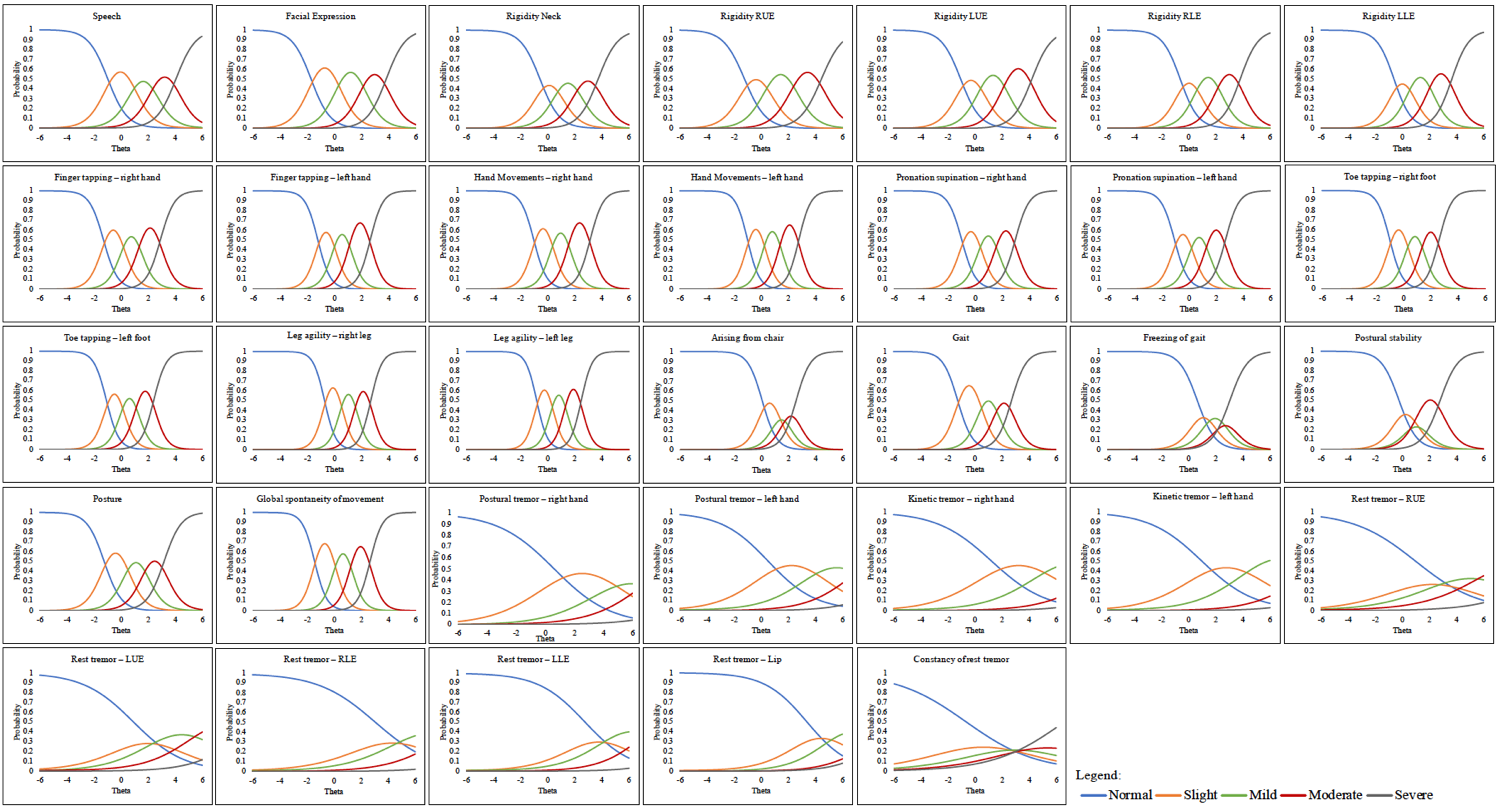Category: Rating Scales
Objective: To investigate the dimensionality of MDS-UPRS Motor Examination (Part 3) using Item Response Theory (IRT).
Background: In Parkinson’s disease (PD), tremor severity behaves differently from other core motor features. However, the most commonly used assessment of overall motor severity, total MDS-UPDRS Part 3 score, does not account for this dichotomy distinction.
Method: Data from 6,382 PD patients were analyzed with graded response IRT approaches to compare unidimensional to multidimensional models of Part 3 data using likelihood ratio test (X2) and Bayesian Information Criterion (BIC) as implemented in the mirt R program. The strength of relationship between items and the latent measure of parkinsonian motor severity (discrimination parameter and threshold values) was assessed.
Results: Comparison of a unidimensional model versus a multidimensional model demonstrated a significantly superior fit for the multi-dimensional model (X2= 16942.75, df = 32, p <0.0005). Exploration of the structure of the multidimensional model (Table 1)revealed two parsimonious factors with the 23 non-tremor items loading on one factor (minimal factor loading 0.541) and the 10 tremor items loading on the second factor (minimal factor loading = 0.441). No items demonstrated dual-factor loadings >0.30. IRT discrimination and location parameters for Part 3 items improved significantly when the 10 tremor items were considered separately from the 23 non-tremor items (Figures 1 and 2).
Conclusion: Multidimensional modeling separating the tremor and non-tremor items provides a better estimate of the relationship of Part 3 item scores to the latent trait measure of motor severity in PD. We suggest that evaluating PD motor severity, as an operationalized summary measure, is best attained through separate analysis and reporting of tremor and non-tremor motor scores.
References: 1. Ramaker C, Marinus J, Stiggelbout AM, van Hilten BJ. Systematic evaluation of rating scales for impairment and disability in Parkinson’s disease. Mov Disord. 2002;17(5):867–76. 2. Goetz CG. The Unified Parkinson’s Disease Rating Scale (UPDRS): Status and recommendations. Mov Disord. 2003;18(7):738–50. 3. Kean J, Reilly J. Item response theory. Lang Test. 1985;2(2):197. 4. Regnault A, Boroojerdi B, Meunier J, Bani M, Morel T, Cano S. Does the MDS-UPDRS provide the precision to assess progression in early Parkinson’s disease? Learnings from the Parkinson’s progression marker initiative cohort. J Neurol. 2019. 5. Gottipati G, Karlsson MO, Plan EL. Modeling a Composite Score in Parkinson’s Disease Using Item Response Theory. AAPS J. 2017;19(3):837–45.
To cite this abstract in AMA style:
M. Tosin, C. Goetz, S. Luo, G. Stebbins. Item Response Theory Analysis of the MDS-UPDRS Motor Examination: Tremor vs. Non-tremor Items [abstract]. Mov Disord. 2020; 35 (suppl 1). https://www.mdsabstracts.org/abstract/item-response-theory-analysis-of-the-mds-updrs-motor-examination-tremor-vs-non-tremor-items/. Accessed December 22, 2025.« Back to MDS Virtual Congress 2020
MDS Abstracts - https://www.mdsabstracts.org/abstract/item-response-theory-analysis-of-the-mds-updrs-motor-examination-tremor-vs-non-tremor-items/



